

Recipe Card. Create beautiful recipes that readers can print, save and review.
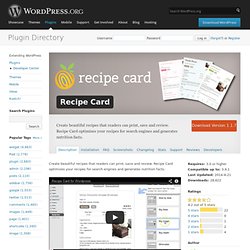
Recipe Card optimizes your recipes for search engines and generates nutrition facts. Make your recipes beautiful. Mix and match over 100 color, font and layout swatches for a recipe template entirely your own. Need more recipe customization? Our visual recipe template editor makes that easy too. Make your recipes visible to search engines. GetMeCooking Recipe Template. A WordPress recipe plugin for food bloggers.
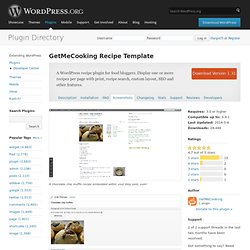
Display one or more recipes per page with print, recipe search, custom layout, SEO and other features. A chocolate chip muffin recipe embedded within your blog post, yum! The recipe edit page Add / edit the ingredients Add / edit the recipe steps Add the recipe tag to a blog post and that's where it shall appear Gain exposure and more visitors by signing up to GetMeCooking Customise the recipe template with these simple options Geek out and customise the recipe template as much as you want Requires: 3.0 or higher Compatible up to: 3.9.1 Last Updated: 2014-5-6 Downloads: 28,448 Ratings 4.7 out of 5 stars Author Support 2 of 2 support threads in the last two months have been resolved.
Got something to say? Post Types. Languages: English • 日本語 • Português do Brasil • Nederlands • Slovenčina • (Add your language) WordPress can hold and display many different types of content.

A single item of such a content is generally called a post, although post is also a specific post type. Internally, all the post types are stored in the same place, in the wp_posts database table, but are differentiated by a column called post_type. WordPress 3.0 gives you the capability to add your own custom post types and to use them in different ways. Default Post Types There are five post types that are readily available to users or internally used by the WordPress installation by default : Wordpress: Creare Custom Post Type facilmente. Custom Post Type: come strutturare i nostri contenuti?
Grazie all’introduzione dei Custom Post Type in WordPress 2.9, il nostro motore di blogging preferito ha fatto l’ultimo passo che lo separava dal diventare un vero e proprio CMS.
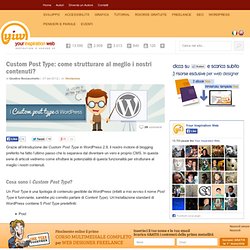
In questa serie di articoli vedremo come sfruttare le potenzialità di questa funzionalità per strutturare al meglio i nostri contenuti. The Complete Guide To Custom Post Types. WordPress has been gaining a foothold in the general content management system (CMS) game for a few years now, but the real breakthrough was the custom post type mechanism which allows for the creation of a wide variety of content.
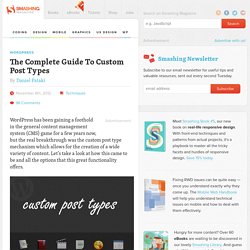
Let’s take a look at how this came to be and all the options that this great functionality offers. 1Some of the custom post types you can create in WordPress. What It Used To Be Like In practice, custom post types have been around for a long time, more specifically since February 17, 2005, when WordPress 1.5 added support for static pages, creating the post_type database field. The wp_insert_post() function has been around since WordPress 1.0, so when the post_type field was implemented in 1.5, you could simply set the post_type value when inserting a post. By version 2.8, the register_post_type() function and some other helpful things were added to the nightly builds, and when 2.9 came out, the functions became available to everyone. Types - Custom Fields and Custom Post Types Management. Types lets you customize the WordPress admin by adding content types, custom fields and taxonomy.
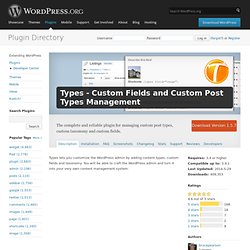
You will be able to craft the WordPress admin and turn it into your very own content management system. If you're an experienced PHP developer, you'll appreciate Types comprehensive PHP API and documentation. Types and the other Toolset plugins let you build complete sites without coding. Views - a powerful content display engineCRED - front-end form builder for content creation and editingAccess - roles and access control management The full Toolset package lets you build complete WordPress sites from within the admin dashboard. Types lets you add custom fields for both posts (meaning, WordPress posts, pages and custom content types), as well as users.
Using Access, you will be able to control what fields different users can edit and view. Types fields come with a built-in CSS editor, letting you design how fields appear in the WordPress admin. Custom Post Type UI.